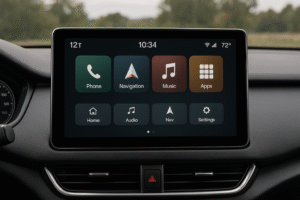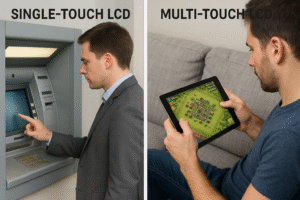
Waterproof touch functionality in LCD devices relies on sealed enclosures, special coatings, and advanced sensors. Choosing materials like silicone gaskets and using epoxy-based PCB coatings keeps moisture away from sensitive electronics.
Applying hydrophobic nano-coatings helps the screen repel water droplets and maintain clear visibility. Adjusting the sensitivity of PCAP touchscreen sensors prevents false touches in wet conditions.
Integrating durable and chemically strengthened glass directly bonded to the embedded LCD reduces moisture issues and improves durability. Following strict waterproof standards like IP67 or IP68 ratings ensures the device can perform safely even when submerged in water.
Regular maintenance, including periodic calibration and inspection of sealing components, sustains reliable touchscreen operation. Understanding these waterproofing methods helps select the right waterproof touchscreen display for industrial, medical, marine, automotive, or outdoor use.
HUA XIAN JING is a design, R&D and production LCD module manufacturing factory, we offer a wide range of LCD module enhancement services such as wide temperature, waterproof, outdoor readable, anti-vibration and so on. Contact us to learn more about our customized LCD module business.
How Do Waterproof LCD Touchscreens Function in Wet Conditions?

Waterproof LCD touchscreens function in wet conditions by using sealed enclosures, hydrophobic coatings, and smart sensor technologies to keep water out and maintain touch accuracy. These screens also rely on strong glass to handle tough environments.
The design of a waterproof touchscreen starts with sealed enclosures that block moisture from reaching internal parts. Manufacturers use special techniques to ensure water stays out while keeping the screen responsive. Another key feature is the hydrophobic coating that pushes water off the surface. This coating stops water from messing up touch inputs. Sensors inside the screen are built to tell the difference between a finger and water droplets. These features work together to make the screen usable even when wet.
Sealed Enclosures:
- Materials include corrosion-resistant metals like stainless steel or aluminum alloys.
- Rubber and silicone gaskets seal the edges tight.
- Chemical-resistant adhesives hold joints together against water.
- The design uses hermetic sealing to stop moisture leaks.
- Embedded LCDs fit into compact, sealed cases for extra protection.
Hydrophobic Surface Treatments:
- Nano-coatings, like silicon-based or fluoropolymer types, repel water.
- Oleophobic layers cut down on fingerprints and oil marks.
- These coatings last through heavy use without wearing off fast.
- They keep the screen clear and touch-sensitive.
Advanced Sensor Technologies:
- Projected Capacitive (PCAP) sensors ignore water and detect finger touches.
- Calibration adjusts sensitivity to avoid confusion from water signals.
- Software filters out false touches caused by moisture.
- Real-time adjustments keep the screen working in changing wet conditions.
Tempered and Chemically Strengthened Glass:
- Thick, strong glass resists scratches and impacts.
- Optical bonding sticks the glass to the LCD layer, cutting down on fogging.
What Makes Waterproof Touchscreens Durable in Harsh Settings?
Waterproof touchscreens stay durable in harsh settings thanks to tough glass and bonding techniques that boost strength and visibility. These features protect the waterproof touch panel from damage and moisture buildup.
Tempered glass adds extra thickness and power to resist cracks or scratches. Optical bonding joins the glass and LCD tightly, which stops condensation from forming in humid places. This combo keeps the screen clear and strong, even in rough or wet conditions.
- Glass Strength:
- Selected for thickness to handle drops and pressure.
- Built to resist scratches from daily use.
- Bonding Benefits:
- Direct bonding reduces moisture trapped inside.
- Improves screen readability in damp or foggy areas.
What Materials and Calibration Ensure Waterproof Touchscreens Work in Wet Environments?

Waterproof touchscreens rely on durable materials like silicone gaskets and epoxy coatings to block moisture. Precise sensor calibration ensures waterproof touchscreens stay responsive in wet conditions.
Manufacturers choose materials that resist water and last in tough settings. Calibration processes fine-tune sensors to ignore water while detecting finger touches. These steps keep the waterproof touch panel reliable in rain or humidity. The right materials and settings make the screen work without fail.
- Gasket and Sealing Materials:
- EPDM rubber resists weathering and stays flexible in wet conditions.
- Silicone gaskets handle high humidity and seal edges tightly.
- Polyurethane offers strong adhesion and durability against moisture.
- Adhesives and Sealants:
- Chemical-resistant adhesives bond parts under prolonged water exposure.
- Sealants maintain integrity in humid or submerged environments.
- Corrosion-Resistant PCB Coatings:
- Silicone coatings protect circuits from moisture damage.
- Acrylic coatings apply easily and resist corrosion.
- Epoxy-based coatings provide a tough barrier against water.
- Sensor Calibration Processes:
- PCAP sensors are tuned to distinguish finger touches from water droplets.
- Differential pressure settings adjust for wet-environment reliability.
- Calibration ensures consistent performance in changing moisture levels.
How Do Material Choices Impact Waterproof Touchscreen Longevity?
Material choices like silicone and epoxy coatings boost the durability of waterproof touchscreens in harsh conditions. These materials protect the waterproof touchscreen display from wear and moisture over time.
High-quality gaskets and coatings shield internal components from water damage. This protection extends the screen’s life in wet or humid environments. Adhesives keep seals tight, preventing leaks that could harm the device. These choices ensure the touchscreen stays functional for years.
- Material Durability:
- Silicone gaskets resist degradation from constant moisture exposure.
- Epoxy coatings maintain protection against corrosion over time.
- Adhesive Reliability:
- Strong adhesives prevent seal failures in humid conditions.
- They ensure long-term water resistance for the touchscreen.
How Can You Ensure Long-Term Durability of Waterproof Touchscreens?
Long-term durability of a waterproof touch screen comes from protecting coatings and enclosures against repeated moisture while following regular maintenance steps. These actions help maintain performance and prevent breakdowns.
Keeping a waterproof touchscreen display reliable over time requires attention to how moisture affects protective layers. Routine care and early fixes play a big role in extending the life of an industrial LCD in harsh settings.
- Moisture Impact on Coatings: Repeated exposure can wear down hydrophobic layers on a waterproof touch panel. Checking for visible wear signs every few months helps catch issues early.
- Sealed Enclosure Checks: Water can seep into weak joints of a screen waterproof setup if not monitored. Regular inspections of gasket conditions ensure the seal stays intact against humidity.
- Proactive Prevention: Identifying common failure spots like loose seals prevents major damage. Using reinforced materials at these points adds extra protection to a waterproof LCD.
- Maintenance Timing: Scheduling routine evaluations every 3-6 months keeps performance steady. This practice stops small issues from growing on a waterproof touch screen monitor.
What Maintenance Steps Keep Waterproof Touchscreens Functional?
Maintenance steps like inspections and reapplying protective layers ensure a display waterproof device stays functional over time.
Regular checks help spot cracks or worn-out parts on a waterproof touchscreen before they fail. Simple repairs or updates address user worries about losing water resistance in a embedded LCD setup.
- Inspection Checklist: Look for gasket wear and coating thinning during checks on a waterproof touch screen. A monthly review of these areas can catch problems before leaks start.
- Reapplication Process: Reapplying hydrophobic coatings every 12-18 months restores water resistance. Replacing damaged seals with new ones ensures a tight barrier on a waterproof touch panel.
What Are the Key Waterproofing Standards and Certifications for LCD Touchscreens?
Key waterproofing standards and certifications for LCD touchscreens include IP65, IP67, and IP68 ratings, each defining specific levels of dust and moisture protection. Additionally, various industries such as automotive, marine, medical, and industrial applications have specialized waterproofing requirements.
Understanding the differences among IP65, IP67, and IP68 ratings is necessary for selecting touchscreen displays suited to specific environmental conditions. Moreover, complying with unique industry-specific standards ensures embedded LCDs operate reliably and safely under required regulatory conditions.
- IP Ratings:
- IP65 Rating:
IP65-certified touchscreens provide complete protection against dust and resistance to water jets from any direction, suitable for outdoor applications experiencing occasional rain or cleaning sprays. - IP67 Rating:
Devices rated IP67 ensure full dust-tight sealing and can withstand temporary submersion in water up to 1 meter depth for 30 minutes, making them suitable for brief exposure in industrial and outdoor environments. - IP68 Rating:
LCD touchscreens with IP68 certification are fully dust-tight and capable of continuous immersion in water beyond 1 meter, often specified by manufacturers depending on user requirements. This rating is ideal for marine and harsh outdoor environments requiring prolonged submersion protection.
- IP65 Rating:
- Testing Processes and Criteria:
- IP testing involves standardized laboratory procedures that measure protection effectiveness against solids and liquids. Tests include controlled dust chambers, pressurized water jets, and specific submersion depths and durations, clearly outlining certification requirements.
- Industry-specific Waterproofing Standards:
Industry Application Waterproofing Requirements Compliance Criteria Industrial LCD IP65 or IP67, chemical resistance, durable gasket sealing IEC and UL standards, regular durability inspections Marine LCD IP67/IP68, saltwater corrosion resistance, robust sealing Maritime regulatory guidelines, environmental exposure tests Automotive LCD IP65/IP67, vibration resistance, temperature variability Automotive safety standards, ISO automotive quality compliance Outdoor LCD IP65/IP68, UV resistance, weatherproof sealing Outdoor environmental standards, weathering durability tests Medical LCD IP65/IP67, sterilization resistance, sealed touch surfaces Medical industry compliance, FDA and
How Do Testing Processes Verify Waterproof Touchscreen Standards?
Testing processes verify waterproof touchscreen standards by simulating real-world water exposure conditions. These tests ensure the waterproof touchscreen display meets IP ratings and industry requirements.
Labs use controlled water jets, submersion tanks, and pressure tests to check seal strength. Passing these tests proves the screen can handle wet environments without leaks. This addresses user concerns about reliability in specific industries. Rigorous testing builds trust in the touchscreen’s performance.
- Testing Methods:
- Water jet tests confirm resistance to high-pressure sprays.
- Submersion tests check seals under deep water conditions.
- Compliance Checks:
- Regulatory audits ensure industry standards are met.
- Material inspections verify corrosion resistance and durability.
FAQ
Can Waterproof Touchscreens Be Used Underwater Continuously?
Only IP68-rated waterproof touchscreens support continuous underwater use. Lower ratings like IP65 and IP67 offer limited, short-term water protection.
Will Waterproof Coatings Affect Screen Clarity?
Quality hydrophobic coatings preserve screen clarity and touch accuracy. Poor-quality coatings may reduce visibility over time.
Do Waterproof Touchscreens Work with Gloves?
Yes, specialized PCAP sensors can detect touches even when users wear thin gloves. Thicker gloves require enhanced sensor calibration.
How Do I Know When Gaskets Need Replacing?
Gaskets need replacement if they appear cracked, hardened, or compressed during routine inspections. Regular inspections help catch these issues early.
Are Waterproof Touchscreens Resistant to Saltwater?
Marine-grade waterproof touchscreens with proper corrosion-resistant coatings and IP68 ratings are specifically designed to resist saltwater exposure.






